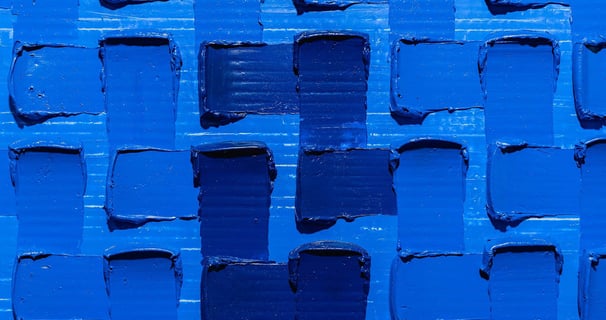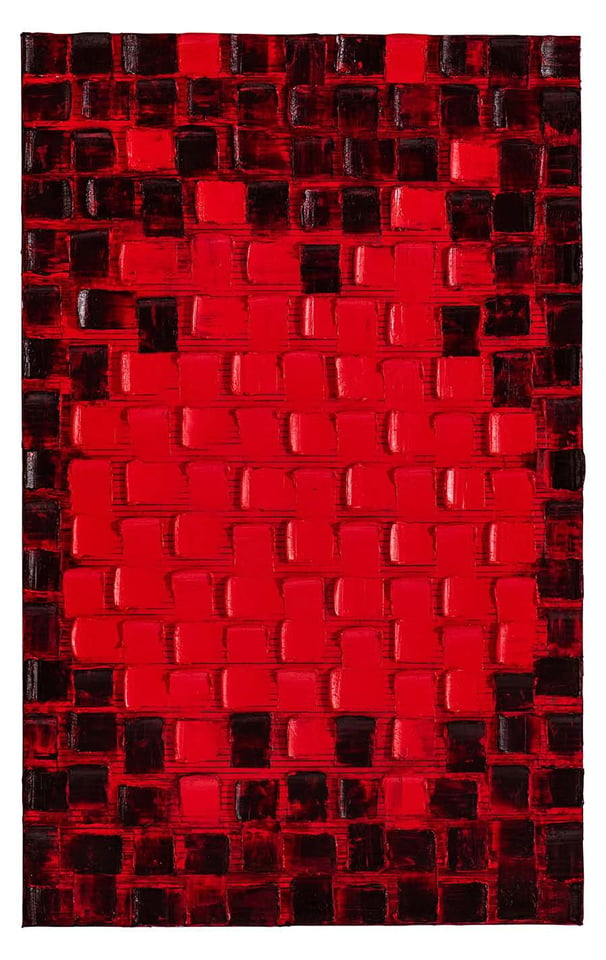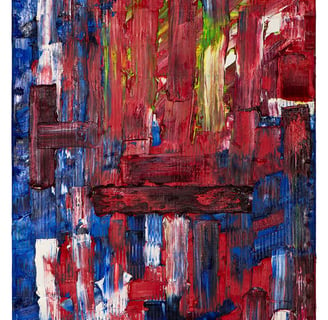Andrew Prouny: Redefining Modern Painting
Andrew Prouny’s first museum exhibition is being held at the Osthaus Museum Hagen. The mostly reclusive artist, who is currently unable to paint due to a severe illness, is being honored with 44 paintings from the years 1982 to 1996. All the works come from a high-caliber collection in Monaco that owns works of international avant-garde from the 20th century. The decision to collect the works of Andrew Prouny, known only to insiders, was made at an exhibition about fifteen years ago. The collector was fascinated by the different painterly expressions of these paintings, which can also be considered as painting objects due to their pastosity. Born in 1960 in Hochheim am Main, Prouny, the son of a German father and a French mother, started his painting career towards the end of the 1970s with a focus on figurative painting. However, he had started relatively early. The works of the then 10-year-old young artist impressed his parents so much that they considered further studies to be quite sensible.
Andrew Prouny loves to work with thick oil paint on cardboard or canvas. His works on cardboard are laminated onto canvas aft er the painting process, and therefore hardly differ from original canvas works. The works exhibited in Hagen were created using pure color pigments. A striking feature of all the works is the power of the color. In some paintings, it appears in a minimalist form, representing itself. In other paintings, there are clearly landscape-inspired works, with imagined glimpses of fields or forest structures. Light is always crucial in these works. For Prouny, color has different functions. Sometimes its his colorful works that send out flashes of light, sometimes it’s the play of light and shadow in the works. Prouny uses both warm colors like red, yellow, orange, and very cold ones like dark violet or dark blue. Each work, therefore, has a very unique character.
Prouny’s art takes place in the tradition of international abstraction. In the era of the Second Modernism after the end of World War II in 1945, initially only tentative, but from the 1950s on, much clearer tendencies in painting emerged that increasingly moved away from the representational. The extrapictorial happenings were at best a weak impulse for abstract painters. The challenge was to find the unknown in painting, as described by the Stuttgart painter Willi Baumeister in his outstanding theoretical book. The central idea revolves around the concept of “Form Art.” Initially, Goethe is quoted from “Maxims and Reflections. Aphorisms and Notes”:
“Everyone sees the material before them, Only he who has something to add finds the content, And the form is a secret to most.”
For Baumeister, an inner “vision” of the artist was important. And alongside the “vision,” a particular artistic-existential state. Andrew Prouny, who does not reveal much about himself and the development of his art, experienced such special moments in his youth that almost compelled him to artistic expression.
It was his intuition that led him over the years to non-representational painting, in which he discovered his greatest possibility of expression. It is completely understandable that the extent of artistic freedom is possible precisely in the medium of abstraction. In his preface to documenta II 1959, Werner Haftmann wrote: “This freedom, however, represents the most immediate way of confronting reality and the facts of one’s own existence that has ever been possible for mankind. Its assumption-free openness changed the relationship to reality and to human nature. For through it, it was recognized that the result of an observation cannot be separated from the observer, that the relation to the object determines its definition and appearance, that the classical domineering contrast between man and object was only one and only a very incomplete way of knowledge…”
Through the world language of abstraction, the entire categories of the image: line, form, color, space, rhythm were brought to their strongest and most radical independent representational status. Painting as an adventure, that’s how one could briefly summarize the thoughts of the pioneer Haftmann. And this adventure, where one does not know whether one will fail — that was clear to Andrew Prouny very soon after the beginning of his artistic activity. But freedom can always mean suffering if one does not have the abilities that Prouny apparently has or had. With every abstract/non-representational painting, it is decided whether a successful result has been created. It is always a struggle for meaningful expression. And this free expression with its global language connects people from very different cultures. The abstract painting is an interpreter between peoples and thus gains a cultural-historical signifi cance. It is not too far-fetched to speak of world culture. For Willi Baumeister, painting was the art of the visible. “From the painter's point of view,” he says in the introduction to “The Unknown in Art,” “painting is the art of making visible something that only becomes visible through him and was not previously present, belonging to the unknown.”
We have given this exhibition the subtitle “Between the Forms.” The deeper meaning becomes clear indeed in a comprehensive view of the exhibition. We have included selected works from the collection of the Osthaus Museum dialogically in the exhibition and thus show that Andrew Prouny’s art has its place in the context of his contemporaries. Each of the exhibited works has its own place in art history. The formal settings of Prouny’s works reveal their specifi c spectrum of expressive possibilities. None of his picture compositions is like the other, all pictures are therefore prototypically designed. They move in a formal alphabet that Prouny has developed for himself. Therefore, it is important to say that these works are created on the way of organic thinking, are circularly designed and do not aim vectorially in one direction. Eachpainting, therefore, claims its own world of form and color.
Georg Baselitz
Prouny, like Baselitz, is driven to express his own individual narrative in art, where traditions and meanings, times, and phenomena in art are sometimes intermixed. Prouny demonstrates deep involvement in historical and cultural themes and likely tendencies to move away from academic forms and methods of presentation, and to use modern materials and techniques and their application and conceptual limitations, as well as atypical working methods of these artists. Subsequently, they will provide additional ideas and perceptions for their complete artistic comparison.
Joseph Beuys
The art of Beuys is deeply rooted in his humanistic worldview. Like Beuys, Prouny also created works in series, conceptualizing them into triptychs, diptychs, and so on. They have similar conceptual and philosophical foundations. Sometimes, Prouny, just like Beuys, uses unconventional materials to create works that go beyond the traditional concept of art. A direct visual parallel is that Prouny partially and conditionally uses collage techniques to create a new layer and aesthetic in viewers, like Schumacher, Prouny uses thick textured layers of oil paints, consisting of various open pigments, creating an intense, almost sculptural appearance.
Raimund Gierke
Deliberately reducing Gierke‘s paintings to a few basic colors, leaving them and highlighting predominantly the color white. Th is is subsequently used by Prouney in its pure form, showing that their white color is immaterial — embodying calmness and silence. The artists have a similar approach to monochrome compositions, focusing on the effects of color and form. Experimenting with structures and using obvious freedom of expression in painting, both artists can be recognized for certain spontaneity and gestures in their works, made with broad brush marks and palette knives. Both artists always focus on strong colors and the emotional impact of shades, creating works with their complex structure, which acquire conditional dynamism by using texture, enhancing the intensity and presence of visuality.“
Oskar Sommer
Prouny and Sommer demonstrate expressive dynamism and a similar approach to the perception of abstract painting in their work. The artists emphasize the feeling of mood. The works of Prouny, like those of Sommer, appear spontaneous and intuitive upon observation, with accents and emotional expressions, through which abstract forms and images are clearly marked. Their works consist of free structural forms with an interacting color palette, embodying an intense color and rich harmony.
Heinz Mack
Mack and Prouny demonstrate a great inclination for experimental approaches in art, using light and color to create visual effects. Prouny uses light and form to provoke an intuitive reaction from viewers. Prouny is known for his paintings, and his approach to art is very diverse and interdisciplinary. Both artists show great interest in abstract art, adhering to similar formal principles of abstraction to create visual and emotional eff ects. Mack and Prouny consider the physical presence and special properties of their works as an integral part of their great visual experience.
Reiner Jochimis
Jochimis‘ contemplative abstractions also belong to optical and monochrome painting. With Prouny, art is also meant to provoke the viewer into a clear dialogue and reflection and contemplation of the author with the viewer. The intensity of color in Prouny and his working methods indicate a specific emotional and psychological reaction as a result, triggered by color harmonies and contrasts. Prouny, unlike Jochimis, successfully experiments with any texture and all possible ingredients, representing a kind of movement in space.
Franco Viola
Viola is one of the few contemporary Italian artists who, relying on national and international traditions, dedicates himself to independence, using a clear traditional approach to painting. Prouny, like Viola, relies on the relatively two-dimensional plane of the canvas. The colors used by Prouny are bright and oft en used in repeating structures to create virtual depth. Viola‘s use of color focuses on the representation and impression of the author himself. Viola fi lters the surface through aesthetics and memory. Prone clearly focuses on the visual emotional impacts of form and color.
Nestor Santana
Santana uses abstraction to achieve an effect on the aesthetic perception of the intellectual viewer. His message is directed at emotions and intuitions, not at pragmatic perceptions of thought and contemplation over paintings. In his paintings, halft ones and forms are conveyed, which are clearly visible, especially in Prouny‘s relatively early work. Prouny, like Santana, relies solely on an abstract, strong virtual language, not based on recognizable symbols but only on the power of color and form. Santana‘s multicultural experience is reflected in his European culture, showing the diversity of creativity, similar to Prouny‘s work, which also has a wide range of visual influences. Their works are characterized by the same energy and dynamism, arising from tensions between traditional images and modern abstractions.
Bernd Schwarzer
In comparison, Schwarzer and Prouny have several obvious parallels and contrasts. Both artists share a love for texture and materiality in painting. Prouny works with thick oil paint, while Schwarzer‘s technique also emphasizes accents, texture, and tactile qualities of the surface. Schwarzer‘s paintings are akin to three-dimensional objects, representing their common approach and a kind of sculptural volume in surface painting. Both artists use thick layers of paint and a fairly vibrant color palette, which once again confirms their undeniable attention to the material aspects of painting. In a detailed art historical and visual comparison, their works and motifs remain common. The intensity and expressiveness of Schwarzer‘s use of paint can also be found in the works of Prouny, as an expression of emotions and painterly symbolism.
Günter Uecker
With Prouny and Uecker, there are very similar physical dimensions and interactions with light, shadow, and structure. They are also uniquely connected by standing in different planes of art between two-dimensional and three-dimensional elements. Prouny also uses recurring moments to create structures and geometric patterns that change depending on the lighting and angle of view of the work. Prouny demonstrates artistic investigations of material transformations of everyday objects through skillful artistic intervention and the use of color. Prouny, or in the case of absence of color as with Uecker, is also a new modern work, aimed at the play of light and shadow, to create new visual impacts.“
Willi Baumeister
Baumeister who realized universal principles of abstract painting and design, created his visually recognizable form, in which, like the levels of contact between surface and form, these artists have similar avant-garde ideas based on conceptual approaches. Universal views of painting are evident in Prouny who uses abstract forms to create movement and dynamism. Prouny places a strong emphasis on color compositions with his powerful colored blocks and shapes. In creating a work, artists with broad brushes and palette knives attack the painterly surface, suggesting and setting specifi c tasks and directions, modeling a new movement and unrestrained energy into their works.“
Kuno Gonschior
Kuno Gonschior is known as a vivid artist and colorist, who in his work dealt with the exploration of color and its impact in space. With Prouny, colorism is also an almost physically tangible component of his paintings. In his paintings, dense masses of color are organically expressed and positioned on the canvas surface, creating a comprehensive effect, inviting the viewer to observe a kind of dance of color. Their conditional hierarchy of light and color creates a painterly space associated with freedom. The parallels are obvious — both artists demonstrate the intensity of color, and sometimes this color vibration closely connects these artists.
Jan Meyer - Rogge
Both artists clearly prefer and emphasize visual perceptions. Rogge expresses this through objects, creating mass in sculpture through its physical volumes and textures of materials. Prouny uses abstract forms and colors to aff ect the viewer through the plane on the wall. Both artists are interested in obvious extensions of the boundaries of infl uence and expansion of various forms in art, offering the viewer to look beyond the obvious and understand their creations more deeply.“
Leo Breuer
Breuer, like Prouny, attaches great importance to the effect and interaction of color throughout his creative life, constantly exploring color harmonies and forms. Prouny, similarly, focuses on the emotional and intuitive impact of color and light. Th ey both construct their compositions, where color is a kind of dominance of novelty in their works. Th e works of Prouny and Breuer are characterized by internal rhythms and movements created by light chords and spatial effects. Both artists apply, in their own way, similar principles to create dynamic perception in their paintings. Both artists are independent and conscious in art. Each went their own way. Only in abstract painting, he was known for seeking new possibilities and expressions in art, implying similar and innovative thinking in Prouny.






Andrew Prouny in the collection of the Osthaus Museum Hagen
In the dynamic field of abstract art, a remarkable figure emerges who embodies both tradition and innovation: the up-and-coming artist Prouny. Characterized by an unmistakable style, Prouny’s art is a kaleidoscope of influences and idiosyncrasies. Engaging in a dialog with the works of established masters such as Joseph Beuys and Georg Baselitz, his works reflect a deep appreciation of the past while bringing a fresh and personal perspective to the world of abstract art. Prouny’s approach is characterized by a unique fusion of forms and methods that he adopts and transforms from his predecessors. His work is characterized by a nuanced use of color and texture that is distinctly different from that of his predecessors. Despite these differences, there are clear echoes of the characteristic styles and symbols of Beuys and Baselitz in his work, which makes Prouny’s art a fascinating object of study for the evolution of abstract art. In the following analysis, Prouny’s artistic methods and stylistic elements will be examined in more detail and discussed in the context of the work of other renowned artists in order to better understand the nuances of his unique contribution to abstract art.
Reach
info@andrewprouny.com